
Andy Lloyd's Dark Star Blog

Blog 42 (September 2016)
Three New Objects Extend Hunt for Planet X
The two scientists, Scott Sheppard and Chad Trujillo, who first recognised the clustering of objects thought to reveal the presence of 'Planet Nine' (1), have announced the discovery of three new objects. All three are highly distant objects (2). Two of them are extended scattered disk objects beyond the traditional Kuiper Belt, and fit reasonably well into the afore-mentioned cluster. The third, perhaps even more amazingly, is an object whose elongated orbit reaches way out into the distant Oort Cloud of comets, but which also never comes closer than the planet Neptune. So, this is the first outer Oort cloud object with a perihelion beyond Neptune, designated 2014 FE
72.
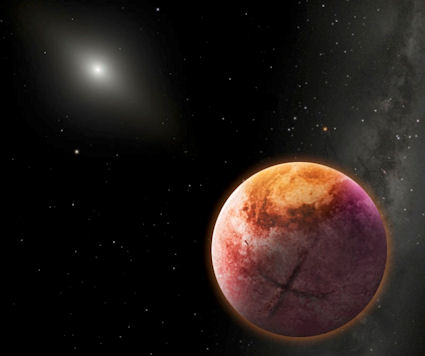
An artist's impression of Planet X. N.B. Not Planet IX...
Image Credit: Robin Dienel
Here's how the announcement of these three new objects has been described in a press release from the Carnegie Institution for Science (3), where Scott Sheppard works:
"
The new objects they have submitted to the Minor Planet Center for designation include 2014 SR349, which adds to the class of the rare extreme trans-Neptunian objects. It exhibits similar orbital characteristics to the previously known extreme bodies whose positions and movements led Sheppard and Trujillo to initially propose the influence of Planet X. "Another new extreme object they found, 2013 FT28, has some characteristics similar to the other extreme objects but also some differences. The orbit of an object is defined by six parameters. The clustering of several of these parameters is the main argument for a ninth planet to exist in the outer solar system. 2013 FT28 shows similar clustering in some of these parameters (its semi-major axis, eccentricity, inclination, and argument of perihelion angle, for angle enthusiasts out there) but one of these parameters, an angle called the longitude of perihelion, is different from that of the other extreme objects, which makes that particular clustering trend less strong. "Another discovery, 2014 FE72, is the first distant Oort Cloud object found with an orbit entirely beyond Neptune. It has an orbit that takes the object so far away from the Sun (some 3000 times farther than Earth) that it is likely being influenced by forces of gravity from beyond our Solar System such as other stars and the galactic tide. It is the first object observed at such a large distance." (4)In their paper, the astronomers argue that the orbital properties of these objects provide further evidence for the existence of an unknown massive planet on an eccentric orbit. The more objects fitting this pattern, the more unlikely it is that this is some kind of statistical 'blip' which can be explained away as coincidence. They maintain that the configuration of this growing cluster of objects is 'anti-aligned' to the perturbing orbit of the Planet X objects shaping their collective anomalous trajectories. The parameters of this as-yet undiscovered Planet X object (or Planet Nine, as named by Mike Brown and Konstantin Batygin in their influential paper published in January 2016 (5)) are becoming steadily more constrained with each new piece of evidence that comes to light.
An inner Oort Cloud object connected with Planet X
The discovery of 2014 FE72 is particularly remarkable. It currently lies about 61 AU away, and achieved perihelion back in 1965 when it was just 36AU away - still quite a long way beyond Neptune, in the Kuiper Belt. But its elongated orbit takes it out to about 3,800AU, within the inner Oort Cloud of comets, in a circuit that lasts a remarkable 86,000 years (6). So, 2014 FE72 effectively transits between the inner Oort Cloud and the Kuiper Belt without ever entering the planetary zone of the solar system. This places it into a quite different category of object than standard long period comets, and extends the range of the 'Sednoids' considerably.
This is obviously an amazing discovery, particularly given this object's current distance. But it doesn't seem to fit readily into the pattern of Sednoids that make up the Planet Nine cluster. I say this because this cluster is envisaged to be a collection of Kuiper Belt Objects which have been drawn up into extreme orbits by Planet Nine's gravitational influence. Yet, 2014 FE72's huge orbit takes it well beyond the range of even Sedna: four times as far, if the figure are to be believed (and Sheppard and Trujillo are cautious about this orbit, given the short observation arc and extreme eccentricity that they're working with (6)). As they describe it (2), this object appears to be an inner Oort Cloud object. Indeed, their press release indicates how this object's aphelion distance makes it subject to external forces, like the galactic tide:
"Another discovery, 2014 FE72, is the first distant Oort Cloud object found with an orbit entirely beyond Neptune. It has an orbit that takes the object so far away from the Sun (some 3000 times farther than Earth) that it is likely being influenced by forces of gravity from beyond our Solar System such as other stars and the galactic tide." 32)
So then why include it in an academic paper whose title points towards Planet X? The implication seems to be that the undiscovered planet has drawn this inner Oort Cloud object down into the solar system. This, potentially, puts this object into a similar category as Niku and Drac, whose retrograde motions may imply a similar origin (7). I think this emerging pattern may also indicate that Planet X (Planet Nine in Dr Brown's parlance) is perturbing objects from both ends of its orbit: some up from the Kuiper Belt, some down from the inner Oort Cloud. This, in turn, implies that its reach into the outer solar system is considerably longer than that envisaged by Brown and Batygin: either in terms of a greater orbital length, or greater mass - or both.
Aligned?
There's a second issue which I'd like to address, which is made obvious by the diagram published alongside the press release. One of the new objects, 2013 FT28, appears to be aligned with Planet X, not anti-aligned. The authors allow that this object does not fit into the cluster as well as the other Sednoids, largely due to its quite different longitude of perihelion.
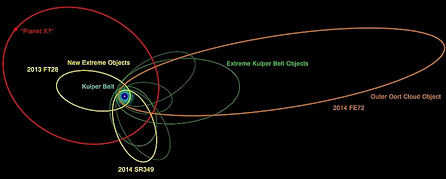
An illustration of the orbits of the new and previously known extremely distant Solar System objects.
The clustering of most of their orbits indicates that they are likely be influenced by something massive and very distant, the proposed Planet X.
Image Credit: Robin Dienel
They also argue for the anti-alignment in their abstract (2), which places Planet X in the opposite side of the sky from the bulk of cluster. Yet, it seems curious that 2013 FT28 seems to buck this trend.
An Exoplanet?
Journalist Mark Kaufman interviewed Scott Sheppard in the wake of this announcement, allowing us to gain some insight into the astronomer's opinions about Planet Nine (which his team is actively hunting). Sheppard estimates the probability that Planet Nine exists at about 80%. He likens the current search to the run-up to the discoveries of other outer solar system planets - Uranus and Neptune - and the dwarf planet Pluto (8). In terms of the origin of this proposed Planet X body, Sheppard's working hypothesis is that it's a rogue intruder from the planetary system of another star in the Sun's initial birth cluster.
“If this turned out to be the case, then we’d know that there were other suns being formed nearby our sun,” Sheppard said. “It would have to be a very dense solar environment, and that would also tell us a lot about the formation of our solar system... Actually, it’s quite possible that the planet has already been in some way imaged. That happened with Uranus, Neptune and Pluto — they were observed but not understood before they were actually detected. Who knows, proof of Planet X {or Planet 9} may already exist in some observatory archive.” (8)
This reflects ideas about the origin of the purported Planet Nine first published by Alexander Mustill et al back in April (9).

Image Credit: NASA
They argue that stars are capable of stealing planets from each other in these early, slow moving star clusters, and that effectively Planet Nine initially began life as the offspring of one of the Sun's sisters:
"A number of lines of evidence suggest that the Sun formed in a sizeable cluster of a few thousand stars , and previous dynamical studies have shown that orbiting bodies at large radii can be transferred between stars in the slow close encounters typical in open clusters. It is indeed possible for the Sun to have captured such a planet from another star in a close encounter in its birth cluster. Our study is complementary to the recent work of Li & Adams (10), who also identify capture in a cluster as a possible source for Planet 9. Whereas these authors consider the capture of planets initially on circular or moderately eccentric orbits, we focus on a scenario in which the Sun captures a highly eccentric planet with a semimajor axis of several hundred au but a pericentre of ~10 au." (9)
Both of these sets of workers find the chances of such a successful capture occurring to be 2% or less (much less, depending upon the constraints applied to Planet Nine orbital characteristics). This seems a pretty bleak possibility, until one considers the considerably remoter probabilities attached to competing theories (i.e. how a sizeable planet could have formed out there way beyond Neptune, and the preliminary protoplanetary disk).
So, the capture of an eccentric rogue planet originating from outside the solar system. My goodness, where have we heard that before?
Written by Andy Lloyd, 3rd-8th September 2016
References:
1) Chad Trujillo & Scott Sheppard "A Sedna-like body with a perihelion of 80 astronomical units" Nature, 507, 471-474, 27 March 2014,
2) Scott Sheppard & Chad Trujillo "New Extreme Trans-Neptunian Objects: Towards a Super-Earth in the Outer Solar System", The Astronomical Journal, 152(6): 221, 6 December 2016
3) Carnegie Science "Hunt for ninth planet reveals new extremely distant solar system objects" 29 August 2016,
4) Carnegie Institution for Science "Hunt for ninth planet reveals new extremely distant solar system objects" 29 August 2016, with thanks to Lee
5) Konstantin Batygin & Michael Brown "Evidence for a Distant Giant Planet in the Solar System" The Astronomical Journal, 151:2, 20 January 2016,
6) '2014 FE72'
7) Andy Lloyd "Going the Wrong Way Round" 14 August 2016
andylloyd.org/darkstarblog41.htm
8) Marc Kaufman "The Case Strengthens For “Planet 9”" 1 September 2016
9) Alexander Mustill "Is there an exoplanet in the Solar system?" MNRAS Letters, 460 (1Pp): L109-L113, 26th April 2016
mnrasl.oxfordjournals.org article
10) Gongjie Li & Fred Adams "Interaction Cross Sections and Survival Rates for Proposed Solar System Member Planet Nine" The Astrophysical Journal Letters, 823(1): L3, 12 May 2016
The Death of the Solar System, and Planet X
New computer simulations which include Planet X in the solar system, have shown that its presence should have a profound effect upon the fabric of the outer planetary system upon the Sun's eventual death (1).
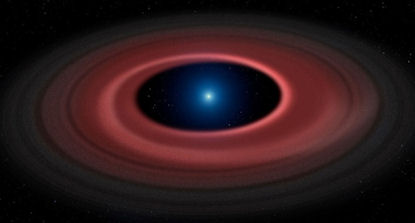
This may seem rather theoretical, but modelling the end of the solar system in this way may give clues as to why rocky debris disks have been spotted around some white dwarfs (the eventual fate of our Sun), as well as why heavy elements appear in the atmospheres of up to 50% of recently formed white dwarfs (2).
"Using a unique code that can simulate the death of planetary systems, Dr Veras [of the University of Warwick] has mapped numerous different positions where a ‘Planet Nine’ could change the fate of the solar system. The further away and the more massive the planet is, the higher the chance that the solar system will experience a violent future. This discovery could shed light on planetary architectures in different solar systems. Almost half of existing white dwarfs contain rock, a potential signature of the debris generated from a similarly calamitous fate in other systems with distant “Planet Nines” of their own.
"In effect, the future death of our sun could explain the evolution of other planetary systems. "The future of the Sun may be foreshadowed by white dwarfs that are 'polluted' by rocky debris. Planet Nine could act as a catalyst for the pollution. The Sun's future identity as a white dwarf that could be 'polluted' by rocky debris may reflect current observations of other white dwarfs throughout the Milky Way," Dr Veras adds." (3)
As stars die, they expand into red giants, engulfing the planets in their inner systems, and driving their outer planets out to more distant orbital positions. Then the red giants collapse into white dwarfs, leaving behind an empty graveyard in their wake. Or so the thinking goes. However, this mechanism fails to account for the observations of warm, dusty disks around many such systems (4, 5). The extant dust shouldn't be there at all. Instead, it should have spiralled down into the red giant, getting swallowed up in the process. Yet, planetary systems seem to be able to survive the death of their stars - at least for a while: There is real-time evidence of planets in white dwarf systems actively disintegrating (2), indicating on-going processes long after the white dwarf has been formed (6).
The presence of a distant binary companion - like an old brown dwarf - or a substantial Planet X-type body, may explain why such anomalous disks and extant planets come to be found in so many white dwarf systems. By their very nature, wide binaries and Planet X-type objects are difficult to discern, both directly and through their indirect gravitational effects. If they provide an explanation for the relative abundance of anomalous warm dust disks around white dwarfs, one might be forgiven for speculating as to whether such substantial extreme outer planets are more populous than previously thought.
Written by Andy Lloyd, 4th September 2016
References:
1) Dimitri Veras "The fates of Solar system analogues with one additional distant planet", Monthly Notices of the Royal Astronomical Society, 463(3): pp2958–2971, December 2016,
2) Susanna Kohler "Disintegrating Planetary Bodies Around a White Dwarf " 15 February 2016
3) University of Warwick "Planet Nine could spell doom for solar system" 30 August 2016
4) Jason Major "Closely-orbiting Stellar Companions Surrounded by "Mystery Dust"" 23 December 2015
5) Christopher Manser et al. "Doppler-imaging of the planetary debris disc at the white dwarf SDSS J122859.93+104032.9" 10 November 2015
MNRAS, 000, 1–13 (20XX)
6) Gemini Observatory "Dusty Old Star Offers Window to Our Future, Astronomers Report" 8 September 2005
Sub-Brown Dwarfs Hiding in Plain Sight
Not so long ago, brown dwarfs (failed stars caught in an awkward in-betweener
zone between stars and planets) were hypothetical bodies. Their
low stellar masses allow for only a very short period of light-emission
in their early years, after which they cool and darken considerably.
"[A] brown
dwarf has too little mass to ignite the thermonuclear reactions by which
ordinary stars shine. However, it emits heat released by its slow
gravitational contraction and shines with a reddish colour, albeit much
less brightly than a star." (1)
It was recognised early on that if they existed at all, they would be
very difficult to spot - and so it proved. In recent years, the
ability to detect these objects has improved considerably, including
more effective infra-red sky surveys. As they have become more
common, the frontier of sub-stellar bodies has dropped in mass into the
ultra-cool stellar bodies known as sub-brown dwarfs - many of which
would equally properly be designated as rogue gas giant planets.
Examples of brown dwarfs and their cooler sub-brown dwarf cousins
These objects tend to have masses below 13 times that of Jupiter (13Mj)
(2). These objects have always interested me greatly, and very
early on in my own research efforts I was advocating the potential
importance of sub-brown dwarfs in the hunt for additional planets
orbiting our own Sun at great distances (3). I used the term 'Dark
Star' to describe these ultra-cool objects; a term suggested by a friend
of mine. Some can be found orbiting stars (usually beyond 50AU)
while others are free-floating entities in their own right.
These kinds of objects began to crop up with increasing frequency.
Many of these early detections were at the earliest stage of their
development, and so still capable of emiting visible and infra-red light
(e.g. (4)), but these young sub-brown dwarfs started to give astronomers
a clearer idea of the general population numbers of their older brethren
lying in the galactic darkness. The WISE infra-red sky survey was
partly designed to seek out nearby brown dwarfs and sub-brown dwarfs.
The result of this survey was pretty disappointing in this regard, as it
didn't seem to find the kinds of populations of BDs expected (5).
That was despite observing some very cool sub-brown dwarfs indeed (6).
An artist's impression of a dust disk encircling a brown dwarf (1)
Now, a new Canadian near-infrared (NIR)
proper motion survey (known in French as the Sondage
Infrarouge de Mouvement Propre (SIMP) survey) (7) has indicated
that there are likely far more ultra-cool dwarfs in our solar
neighbourhood than WISE had so far demonstrated. The team at WISE,
many of whom were top experts on brown dwarfs, may have been surveying too
narrow a compositional range for these enigmatic objects:
"Knowing the abundance and distribution of
brown dwarfs provides key information on the distribution of mass in the
universe, and on the mechanism of brown dwarf formation, for example,
whether they form in isolation or instead are ejected from larger
planetary systems. To that end, the team, led by Jasmin Robert of
Université de Montréal, believed that although hundreds of ultracool
brown dwarfs have already been discovered, the techniques used to
identify them were overlooking those with more-unusual compositions,
which would not show up in the color-based surveys generally used.
"So they surveyed 28 percent of the sky and
discovered 165 ultracool brown dwarfs, about a third of which have
unusual compositions or other peculiarities. When talking about brown
dwarfs, ultracool means temperatures under about 3,500 Fahrenheit or
2,200 kelvin. “The search for ultracool brown dwarfs in the
neighborhood of our own Solar System is far from over,” said [Carnegie’s Jonathan]
Gagné. “Our findings
indicate that many more are hiding in existing surveys.”"
(8).
This provides great hope for those of us who advocate the existence of a
sub-brown dwarf object in the outer solar system (including Nemesis,
Tyche, and the Dark Star). Simply put, assumptions made about
these objects may have been too restrictive, allowing a great many of
them to have slipped through the net. Scientists working with data
from WISE may have missed a solar system sub-brown dwarf, and then
wrongly dismissed it as impossible.
Written by Andy Lloyd, 7th September
2016
References: 1) European Southern Observatory "Even Brown Dwarfs May
Grow Rocky Planets: ALMA sizes up grains of cosmic dust around failed
star" 30 November 2012
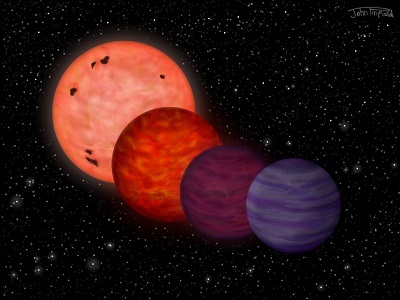
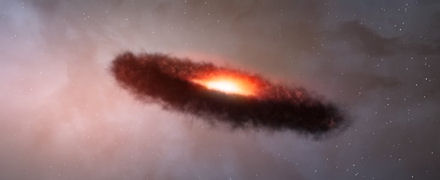
2) 'Brown dwarf'
wikipedia.org/wiki/Brown_dwarf
3) Andy Lloyd "The Dark Star Theory" 1999 onwards
4) Daniel Stolte "Brown Dwarf Found Orbiting a Young Sun-Like Star" 28 July 2010
5) Ian O'Neill "Brown Dwarfs, Runts of Stellar Litter, Rarer than Thought" 12 June 2012
6) NASA/JPL "NASA's Spitzer and WISE Telescopes Find Close, Cold Neighbor of Sun" 25 April 2016
7) Jasmin Robert et al. "A Brown Dwarf Census from the SIMP Survey" The Astrophysical Journal, 830(2): 144, 18 October 2016
8) Carnegie Science "Brown Dwarfs Hiding in Plain Sight in our Solar Neighborhood" 6 September 2016, with thanks to Lee
Could Subaru Spot Nibiru?
Almost nine months after the release of their paper about the likely existence of Planet Nine (1), Drs Mike Brown and Konstantin Batygin have secured a sizeable chunk of valuable time on the Subaru telescope, based in Hawaii. If they're right about where it is, and luck is on their side, then they may detect the elusive planet within weeks.
Brown and Batygin think they’ve narrowed it down to roughly
2,000 square degrees of sky near Orion, which will take
approximately 20 nights of telescope time to cover with the powerful
8.2-meter optical-infrared Subaru telescope
at the summit of Maunakea, Hawaii, which is operated
by the National Astronomical Observatory of Japan (2).
Planet Nine Image Credit: Caltech
Mike Brown is quite gung-ho about it, as can be gleaned
from these extracts from a recent interview with the L.A. Times:
""We are on the telescope at the end of
September for six nights. We need about 20 nights on the telescope to
survey the region where we think we need to look. It’s pretty
close to the constellation Orion...We’re waiting for another couple of
weeks before it’s up high enough in the sky that we can start observing
it and then we’re going to start systematically sweeping that area until
we find it.
""It makes me think of the solar system
differently than I did before. There’s the inner solar system, and now
we are some of the only people in the world who consider everything from
Neptune interior to be the inner solar system, which seems a little
crazy."" (3)
Let's hope they're on the money. They have quite a lot to say
about some of the correspondence that comes their way from members of
what might loosely be termed 'the Planet X community'. Their major
objection to any allusions to the fabled planet Nibiru stem from Planet
Nine's projected orbit lying well beyond Neptune's. Zecharia
Sitchin, by contrast, maintained that Nibiru must return periodically to
the site of the 'Celestial Battle', at the asteroid Belt during
perihelion (4).
Planet Nine's orbit is approximated in my 2005 book 'Dark
Star' p168
For some years, my own research has led me to
realise that a sizeable Planet X body must lie well beyond the outer
planets of the solar system. Indeed, a diagram I put into my 2005
book shows the 'Dark Star' as moving around the Kuiper Belt (itself a
sort of asteroid belt located beyond Neptune) at perihelion (5), rather
than moving in to the inner solar system (even by Dr Brown's
definition). The same diagram shows the Dark Star moving out to
the inner Oort Cloud at aphelion.
Of course, I am not Zecharia Sitchin, and my attempts to revise some of
his ideas in the face of physics and planetary science have not always
been met with glee by his advocates. So, Dr Brown is right to say
that his version of Planet X does not correlate with Nibiru - at least
in terms of its perihelion distance (there are other markers which are
uncannily similar (6), which he tends to avoid mentioning in his
self-evident desire to debunk Nibiru).
A diagram of the Dark Star's orbit I published on my
website some years ago
But Planet Nine does correlate very well with the orbital attributes
that I claimed for the 'Dark Star'. Where my own version of this
sizeable Planet X object differs from the proposed Planet Nine is mass;
Planet Nine is Neptune-sized, while I envisioned a sub-brown dwarf
object of several Jupiter masses. Perhaps this object's position
is more distant than Brown and Batygin think, with a greater mass than
the 10+ Earth masses they attribute to it (which, incidentally, is also
a figure originally proposed by Sitchin). If my sub-brown dwarf
idea is to work, then there has to be a good reason why such a sizeable
object has evaded detection, and I've addressed these recently in
various blogs and a scientific paper (7) (which was, predictably,
rejected by the astrophysics archive ArXiv after six months of frenetic
non-deliberation).
It seems to me that we all hold pieces of this puzzle. Sitchin may
have got aspects of this wrong, with his original thesis that Nibiru
returns to the 'hammered bracelet', or asteroid belt. But, then,
that was before we realised that the solar system has two asteroid belts
- the second being the Kuiper Belt. Perhaps he simply got the
wrong asteroid belt...
I seem to have got the orbit closer to the
mark, but perhaps overshot with the mass. Maybe it is still possible to
have a habitable moon orbiting a very sizeable Planet Nine, but my general thesis calls
for a larger gas giant. Perhaps that allusion to a sub-brown dwarf
was unnecessary, as liquid water seems to be able to exist in places
previously unconsidered, like Mars and Saturn's moon Enceladus.
Anyway, coming back to the hunt for Planet Nine, I note that Dr Mike
Brown is scheduled to provide a press briefing at the 48th
annual meeting of the Division for Planetary Sciences (DPS) of the
American Astronomical Society (AAS) in Pasadena next month.
Dr Brown's briefing, which may take one of a number of formats -
dependent, I suppose, on how big the news from Subaru turns out to be -
is scheduled for Wednesday 19th October (8). Stay tuned!
Written by Andy Lloyd, 19th September
2016
References: 1) Konstantin Batygin & Michael Brown "Evidence for a Distant Giant
Planet in the Solar System" The Astronomical Journal,
151:2, 20 January 2016,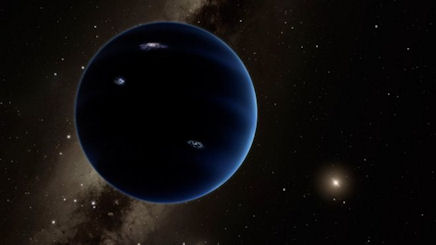
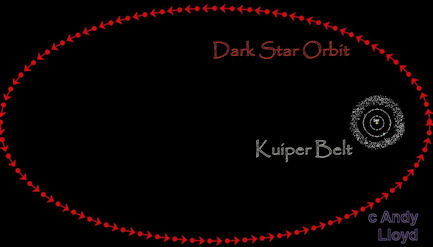
2) Christopher Crockett "New clues in search for Planet Nine" 5 July 2016
3) Patt Morrison "Patt Morrison asks: Caltech astronomers Mike Brown and Konstantin Batygin on finding a replacement for Pluto" 14 September 2014, with thanks to Lee
4) Zecharia Sitchin "The Twelfth Planet" Avon 1976
5) Andy Lloyd "Dark Star: The Planet X Evidence" p168, Timeless Voyager Press, 2005
6) Andy Lloyd "Planet Nine Constellations Predicted by Sitchin, and IRAS" 26 January 2016
andylloyd.org/darkstarblog34.htm
7) Andy Lloyd "The Cumulative Effect of Intermittent Interstellar Medium Inundation Upon Objects In The Outer Solar System" Feb 2016, DOI: 10.13140/RG.2.1.5112.5526 - an updated version (22/2/16) is available here:
8) American Astronomical Society "2nd Media Advisory, 48th DPS / 11th EPSC, Pasadena, CA, 16-21 Oct. 2016" 14 September 2016 (Briefing no longer available online)
Edging Closer to Extraterrestrial Life
Two announcements this month have strengthened arguments for the potential for life in the solar system. The first is NASA's much-trailed press release about water geysers observed climbing over 100 miles into space from the surface of Jupiter's moon Europa (1). This is really confirmation of geyser activity previous observed by the Hubble Space Telescope, announced in late 2013 (2). Although the methodology is different in this case, the result is the same: water is spewing out into space from Europa, likely released as tidal forces open up surface vents. This kind of activity appears to be variable, depending upon Europa's distance from Jupiter as it orbits the gas giant.
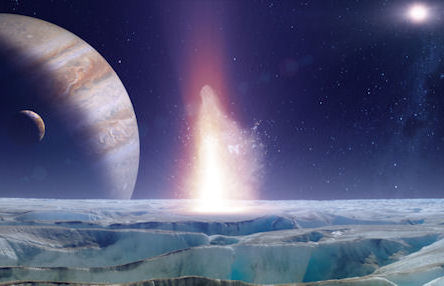
This variability likely indicates the existence of a
substantial sub-surface ocean, the volume of which
exceeds all the oceans of Earth:
"Active geysers have only been
seen when the moon is furthest from Jupiter. But
the researchers could not detect any sign of venting
when Europa is closer to Jupiter. One explanation
is that the long fractures in the ice crust experience
more stress as gravitational tidal forces push and pull
on the moon and so open vents at larger distances from
Jupiter. The vents are narrowed or closed when at
closest approach to the gas giant planet. Kurt
Retherford, of the Southwest Research Institute, points
out that "the plume variability supports a key
prediction that we should see this kind of tidal effect
if there is a subsurface ocean on Europa"."
(3)
Excitingly, these vents offer an opportunity to potentially gain access into the deep sub-surface ocean, far below the billiard ball-like global ice cap. First, the positions of these vents would need to be determined by more accurate observations using, say, the infrared vision of NASA’s future James Webb Space Telescope, scheduled to launch in 2018. Then, flybys by future space probes, while the moon is at it furthest from Jupiter, could enable the contents of these plumes of water to be analyses in more detail, to give an insight into the composition of the ocean within.
Perhaps, one day, these same conduits to the sub-surface oceans might provide an accessible point for drilling down through the ice. After all, where there's water and warmth generated by the tidal forces acting upon Europa by Jupiter's immense gravitational field, these could be life.
All of this should act as a reminder of the potential for habitable environments on moons orbiting substantial planets elsewhere. I alluded to Europa when I first wrote about the Dark Star, arguing that a moon orbiting a sub-brown dwarf might enjoy even more promising conditions (4). Like a proper atmosphere, and aqueous surface oceans.
Complex Organic Molecules on a Comet
The second of this month's announcements is more
significant I think, but enjoyed rather less of the
spotlight. ESA's Rosetta spacecraft, orbiting
comet 67P/Churyumov-Gerasimenko,
has detected complex, solid organic matter within dust
particles emanating from the comet, using its
dust-analysing COSIMA (COmetary Secondary Ion Mass
Analyser) instrument:
"...The carbon in this organic
material is bound in very large macromolecular
compounds, analogous to the insoluble organic matter
found in the carbonaceous chondrite meteorites.
The organic matter in meteorites might have formed in
the interstellar medium and/or the solar nebula, but was
almost certainly modified in the meteorites’ parent
bodies. We conclude that the observed cometary
carbonaceous solid matter could have the same origin as
the meteoritic insoluble organic matter, but suffered
less modification before and/or after being incorporated
into the comet." (5)
The organic material is so complex that the ESA team is unable to provide it with a proper chemical formula or name (6). The carbon in the molecules is found to be mixed with other familiar elements often seen in carbonaceous chondrite meteorites, such as sodium, magnesium, aluminium, silicon, calcium and iron. Exceptionally, however, there is the presence of much more hydrogen in the comet’s samples than in meteorites. This natural combination of carbon and hydrogen provides us with hydrocarbons, the potential complexity of which is vast.
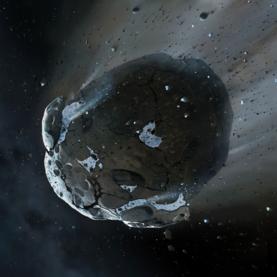
It's uncertain as to whether such complex material formed in the interstellar medium prior to the formation of the solar system, or as a result of it. But it strengthens the arguments made for the concept of 'panspermia', specifically relating to the spread of life between planets and star systems by the movement of comets carrying complex organic chemistry - and even biochemical materials (note that amino acids have already been detected in the coma of this self-same comet (7). Upon impacting 'virgin' planets, these materials could, given the right conditions, spark the emergence of life.
Other Ultra-Violet Light Sources
Comets from the outer solar system seem
more likely to harbour this kind of complex chemistry
than asteroid materials closer to the Sun, as the latter
are subject to heating, and thus the removal of volatile
materials often containing hydrogen. So, it stands
to reason that planets, and their moons, located in the
outer solar system are more likely to mop up these kinds
of materials over time. That principle also
applies to the dwarf planets out there, like Pluto, and
other Kuiper Belt Objects. Pluto's reddish hue is
probably due to the presence of complex heteropolymer
chemicals known as tholins, the formation of which need
not require direct light from the Sun:
"Experts have long thought that
reddish substances are generated as a particular color
of ultraviolet light from the sun, called Lyman-alpha,
strikes molecules of the gas methane (CH4) in Pluto’s
atmosphere, powering chemical reactions that create
complex compounds called tholins. The tholins drop to
the ground to form a reddish “gunk.” Recent measurements
with New Horizons’ Alice instrument reveal that a
diffuse Lyman-alpha glow falling on Pluto from all
directions in interplanetary space is strong enough to
produce almost as much tholin as the direct rays of the
sun. “This means Pluto’s reddening process occurs even
on the night side where there’s no sunlight, and in the
depths of winter when the sun remains below the horizon
for decades at a time,” said New Horizons
co-investigator Michael Summers, George Mason
University, Fairfax, Virginia." (8)
Lyman-alpha radiation is at the extreme end of the ultra-violet range in the electromagnetic spectrum, with a wavelength of ~120nm. This diffuse ultra-violet light source is emitted by various regions of our Milky Way galaxy, as a result of the cooling down of gaseous hydrogen atoms in vast stellar nurseries. This galactic ultra-violet radiation was detected by the Voyager spacecraft, as they escaped the more intense glow of Lyman-alpha radiation generated by the Sun (9). So, bodies in the outer solar system are benefitting from irradiation of high-energy ultra-violet radiation not only from the Sun, but also from the Milky Way galaxy, and beyond. These combined Lyman-alpha glows can drive forward chemical processes in the outer solar system, resulting in the reddening of many Kuiper Belt Objects. These processes can steadily build the complexity of organic materials on these bodies.
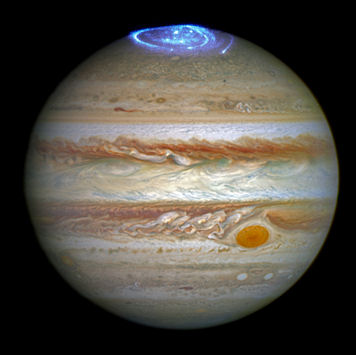
Image Credit: NASA, ESA, and J. Nichols (University of Leicester)
However, a cautionary note: Ultra-violet light is much less helpful for biological processes, like photosynthesis. So, let's imagine that, in time, astronomers discover a Dark Star object in the solar system which is capable of maintaining a viable atmosphere on one of its moons. This Dark star (a sub-brown dwarf which is more massive, but also more condensed than Jupiter) would be more than capable of emitting some radiation of its own. See, opposite, for example, Jupiter's remarkable ultraviolet auroras imaged earlier this year by the HST (10). The Juno spacecraft has been similarly hard at work, sending back images of the southern aurora, in infra-red, as well as the first ever pictures of Jupiter's bluish north pole cloud cover (11).
In the presence of liquid surface water,
one can readily imagine that the Lyman-alpha radiation
falling upon a warmed
moon orbiting a Dark Star - as well as supplementary radiation from the Dark
Star auroras itself - could drive forward some very exciting surface
chemistry. But it would be unable to provide a
plant with the energy it needs through photosynthesis; a
process requiring visible (especially red and blue)
light. A different, entirely alien biological
process would be needed to harvest the energy from this
high-energy ultra-violet radiation.
Written by Andy Lloyd, 29th September
2016
References: 1) NASA Press Release 16-096 "NASA’s Hubble Spots Possible Water Plumes
Erupting on Jupiter's Moon Europa" 26 September 2016
2) Rachel Feltman "New evidence of geysers erupting from Europa’s icy ocean" 27 September 2016
3) HST Press Release heic1322 "Hubble discovers water vapour venting from Jupiter’s moon Europa" 12 December 2013
4) Andy Lloyd "Dark Star: The Planet X Evidence" Timeless Voyager Press, 2005
5) Nicolas Fray et al "High-molecular-weight organic matter in the particles of comet 67P/Churyumov–Gerasimenko" Nature, doi:10.1038/nature19320, 7 September 2016 with thanks to Eitan
6) Emily "Rosetta Catches Dusty Organics" 7 September 2016
7) Kathrin Altwegg et al "Prebiotic chemicals—amino acid and phosphorus—in the coma of comet 67P/Churyumov-Gerasimenko" Science Advances, 2: 5, e1600285, 27 May 2016
sciencemag.org article/content
8) NASA "Pluto: The 'Other' Red Planet" 3 July 2015
9) Davide Castelvecchi "Voyager Probes Detect "Invisible" Milky Way Glow" 3 December 2011
nationalgeographic.com article
10) NASA "Hubble Captures Vivid Auroras in Jupiter’s Atmosphere" 30 June 2016
11) NASA "Jupiter’s North Pole Unlike Anything Encountered in Solar System" 2 September 2016

You can keep informed of updates by following me on Twitter:
![]()
Or like my Facebook Page: https://www.facebook.com/darkstarandylloyd